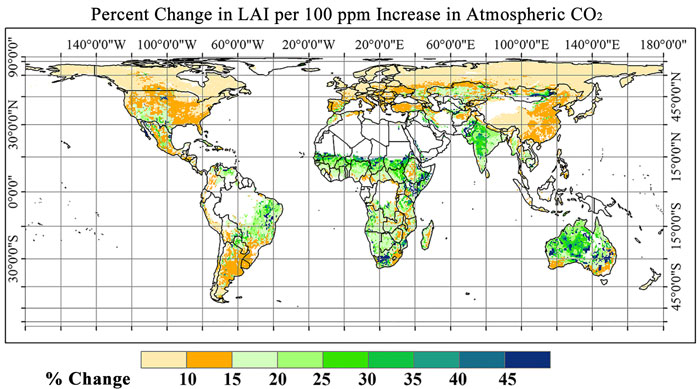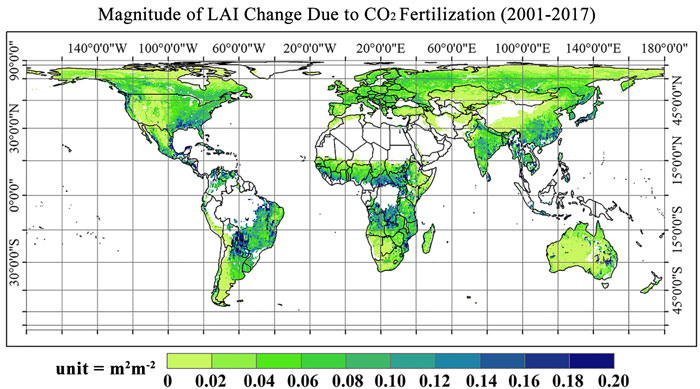CO2 Fertilization Effects on Global Leaf Area Index
Wang, M., Chen, J.M. and Wang, S. 2020. Reconstructing the seasonality and trend in global leaf area index during 2001-2017 for prognostic modeling. Journal of Geophysical Research: Biogeosciences 125, e2020JG005698.
In the past two decades numerous studies have confirmed rising atmospheric CO2 concentrations are benefitting ecosystems all across the globe thanks to the well-known growth-promoting, water-saving and stress-alleviating benefits of CO2 fertilization (see reviews of many such papers archived in our Subject Index under the heading Biospheric Productivity: Global, The Recent Past). The latest study to add to this growing body of evidence comes from Wang et al. (2020).
What Wang et al. did was use climate and soil variables and a biochemical model to reconstruct global leaf area index (LAI) values for the period 2001-2017. LAI is a key vegetation structural parameter that “controls many biophysical processes in the [plant] canopy, such as radiation absorption, photosynthesis, rain interception, and evapotranspiration.” After reconstructing their LAI dataset, the authors explored the mechanisms controlling global LAI, with a specific focus on the impact of CO2 fertilization.
In discussing their findings Wang et al. report “the average global LAI increase due to CO2 fertilization was 0.05 m2 m-2 (about 5.0% of mean global LAI) from 2001 to 2017,” excluding tropical evergreen broadleaf forests for which they had no data. The spatial pattern of LAI change due to CO2 fertilization over the 18-year period is shown in Figure 1 and indicates the CO2 effect was strongest near the equator and diminished somewhat toward the poles. Nevertheless, the researchers report “the effects of CO2 fertilization on LAI were positive in all global vegetated areas and
[yielded an]
averaged value of 13.4% per 100 ppm at the global scale,” once again excluding tropical evergreen broadleaf forests for which they had no data. The relationship between percent change in LAI per 100 ppm increase in atmospheric CO2 is presented in Figure 2, which once again shows a stronger signal of CO2 fertilization near the equator and mid-latitudes as opposed to the high latitudes.
The findings of Wang et al. are similar to that reported previously by Liu et al. (2006) and Zhu et al. (2016)), who also studied the relationship between LAI and CO2 fertilization, but who did so using independent satellite-derived LAI data. In each instance these additional authors also demonstrated that rising atmospheric CO2 is enhancing LAI across the globe, leading to enhanced ecosystem productivity and a great greening of the terrestrial biosphere.
Atmospheric CO2, it’s not the demon so many make it out to be. Rather, it’s the elixir of life!

Figure 1. The spatial pattern of the magnitude of LAI change over the period 2001-2017 that is due to CO2 fertilization (i.e., the corresponding rise in atmospheric CO2 over this 18-year period). Source: Wang et al. (2020).

Figure 2. Spatial patterns of the averaged coefficients of the effect of CO2 concentration on leaf area index (LAI) over the period 2001-2017. The units are in percent LAI change per 100 ppm increase in atmospheric CO2. Source: Wang et al. (2020).
References
Liu, S., Liu, R. and Liu, Y. 2010. Spatial and temporal variation of global LAI during 1981-2006. Journal of Geographical Sciences 20: 323-332.
Zhu, Z., Piao, S., Myneni, R.B., Huang, M., Zeng, Z., Canadell, J.G., Ciais, P., Sitch, S., Friedlingstein, P., Arneth, A., Cao, C., Cheng, L., Kato, E., Koven, C., Li, Y., Lian, X., Liu, Y., Liu, R., Mao, J., Pan, Y., Peng, S., Penuelas, J., Poulter, B., Pugh, T.A.M., Stocker, B.D., Viovy, N., Wang, X., Wang, Y., Xiao, Z., Yang, H., Zaehle, S. and Zeng, N. 2016. Greening of the Earth and its drivers. Nature Climate Change DOI: 10.1038/NCLIMATE3004. Posted 13 January 2021
This article appeared on the CO2 Science website at http://www.co2science.org/articles/V24/jan/a5.php
]]>